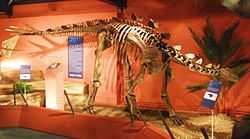Lourinhã Formation
| Lourinhã Formation Stratigraphic range: Late Jurassic | |
|---|---|
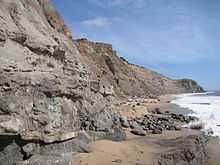 | |
| Type | Geological formation |
| Location | |
| Country |
|
The Lourinhã Formation is a geological formation in western Portugal, named for the municipality of Lourinhã, from which a wide array of fossils comes. The formation is Late Jurassic in age (Kimmeridgian/Tithonian) and is notable for containing a fauna similar to that of the Morrison Formation in the United States and the Tendaguru beds in Tanzania.
Besides the fossil bones, Lourinhã Formation is well known for the fossil tracks[1] and fossilized dinosaur eggs.[2]
The geological subdivisions are the Amoreira-Porto Novo Members and the Sobral Unit.[3]
Dinosaurs of the Lourinhã Formation
In a 2003 study, an analysis of all Portuguese dinosaurs was published. The study created a cladogram showing the possible relations of all Portuguese dinosaurs, including those at the time known from the Lourinhã Formation.[4]
| Dinosauria |
| |||||||||||||||||||||||||||||||||||||||||||||||||||||||||||||||||||||||||||||||||||||||||||||||||||||||||||||||||||||||||||||||||||||||||||||
| |
Saurichia
Theropods
Color key
|
Notes Uncertain or tentative taxa are in small text; |
| Genus | Species | Member | Material | Notes | Images |
|---|---|---|---|---|---|
|
Abelisauridae indet.[5] |
Intermediate[5] |
Teeth; ML 966, Ml 327.[5] |
Potentially diagnostic abelisaur teeth.[5] |
||
|
A. europaeus[6] |
Porto Novo Member[6] |
Two specimens, covering much of the body.[7] |
Potentially a synonym of the type species, A. fragilis. |
||
|
A. fragilis[6] |
Porto Novo Member[6] |
Two specimens, covering much of the body.[7] |
Now thought to represent a distinct species of Allosaurus, A. europaeus.[6] |
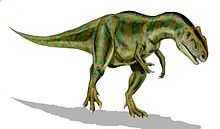 Allosaurus fragilis | |
|
Potentially a synonym of the type species, C. nasicornis. Sometimes referred to as C. sp., giving indication of possible distinctiveness or of being intermediate.[9] |
|||||
|
Three individuals, one largely complete; over 100 eggs with significant amount of skeletal material.[10] |
Has come out in various places in the tree, erroneously said to be a megalosaur,[6] mostly excepted to be a carnosaur, probably allosauroid, or basal coelurosaur. Currently unstable on the tree.[10] |
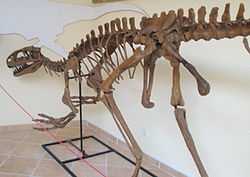 Reconstructed skeleton in the Museum of Lourinhã 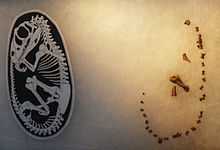 Embryo | |||
|
M. insignis[5] |
Teeth.[5] |
Invalid. Teeth belong to various other theropod taxa.[5] |
|||
|
M. pombali[5] |
Teeth.[5] |
Invalid. Teeth belong to various other theropod taxa[5] |
|||
|
M. sp.[5] |
Tooth fragment.[5] |
Invalid; Dubious.[5] |
|||
|
R. aff. gilmorei[5] |
Tooth; ML 939[5] |
Only definite record of this taxon is from the Late Cretaceous of North America, despite erroneous and referrals from other sites in Portugal. Probably a close relative of Richardoestesia and not an actual representation of the taxon.[5] |
|||
|
T. gurneyi[11] |
Maxilla, Teeth, Femur; Egg clutch and embryos.[6][11][12][13] |
Largest known European theropod. Previous known as Portugal populations of the type species, or as T. sp., before description in early 2014.[11] |
 Skeletal restoration showing the size of T. gurneyi, known remains highlighted. | ||
|
T. tanneri[11] |
Now described as a distinct species of Torvosaurus, T. guryeni. Sometimes referred to as T. sp. in the past.[11] |
 Life restoration of T. tanneri | |||
Sauropods
Color key
|
Notes Uncertain or tentative taxa are in small text; |
| Genus | Species | Member | Material | Notes | Images |
|---|---|---|---|---|---|
|
One specimen. Vertebrae; potentially other parts of the body.[14][15] |
|||||
|
Diplodocidae indet.[15] |
Intermediate[15] |
One Dorsal Vertebra[15] |
Regarded by Mannione et al. (2012) as being unique from Dinheirosaurus and possibly indicating another diplodocid in the formation, but being non-diagnostic it doesn't warrant description.[15] |
||
|
L. alenquerensis[9] |
|
||||
|
L. atalaiensis[16] |
Fragmentary material.[16] |
A large brachiosaur, a close relative of Brachiosaurus proper.[16] |
|||
|
Z. atlanticus[9] |
Amoreira-Porto Nove Member[9] |
Holotype: Tooth, cervical neutral arch, forelimb, various other fragments.[9] |
No described close relatives from the Morrison Formation or Tendaguru beds; instead allied to other European taxa. Note however teeth from the Tendaguru beds might belong to Turiasauria, as Zby.[9] |
||
Ornithichia
Color key
|
Notes Uncertain or tentative taxa are in small text; |
| Genus | Species | Member | Material | Notes | Images |
|---|---|---|---|---|---|
|
T. cuneatus[4] |
Amoreira-Porto Novo Member[9] |
||||
|
A. kuehnei[4] |
|||||
Thyreophorans
Color key
|
Notes Uncertain or tentative taxa are in small text; |
| Genus | Species | Member | Material | Notes | Images |
|---|---|---|---|---|---|
|
D. armatus[17] |
|||||
|
D. brodricki[18] |
Eleven tracks; Nine pes and two manus prints.[18] |
The tracks can be separated into three different morphologies, though all fall within range of the taxon. Association of the pes and manus tracks to the same taxon cannot be directly supported. Preserve various well preserved skin impressions. Largest prints are larger than those from the type horizon. The tracks are individually represented and do not form any sort of trackway, thought one print is associated with giant ornithopod track,[19] potentially representing that the creatures were traveling together or were otherwise going to a similar location. Another is similarly associated with theropod and sauropod prints.[18] |
|||
|
D. zbyszewskii[4] |
|||||
|
M. longicollum[17] |
Holotype, neck, partial skull, forelimbs, ribs. Tentative juvenile specimen assigned to this taxon.[17] |
Stegosaur with unusually long neck of 17 cervicals, with more neck vertebrae than most sauropods.[17] |
| ||
|
S. cf. ungulatus |
|||||
Ornithopods
Color key
|
Notes Uncertain or tentative taxa are in small text; |
| Genus | Species | Member | Material | Notes | Images |
|---|---|---|---|---|---|
|
Intermediate[20] |
Limb material.[20] |
Now referred to its own genus, Draconyx, along with some other material.[20] |
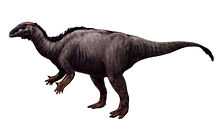 Reconstruction | ||
|
D. loureiroi[20] |
Bombarral Member[20] |
Two specimens; holotype, relatively incomplete, and a femur.[20] |
|||
|
D. sp.[4] |
Sobral Unit |
||||
|
H. sp.[4] |
Amoreira-Porto Novo Member[9] |
||||
|
Ornithopoda indet.[19] |
Intermediate[19] |
Single track.[19] |
Gigantic track indicating an ornithopod with a hip height of 2.5 meters. No known Jurassic Ornithopod reaches this size; only known evidence for such sizes in this group at the time. Found alongside Deltapodus print.[19] |
||
|
P. henkelli.[4] |
|||||
Flora of the Lourinhã Formation
| Genus | Species | Member | Material | Notes | Images |
|---|---|---|---|---|---|
|
Pterophyllum |
P. mondeguensis |
||||
|
P. sp. |
|||||
|
Sphenolepis |
S. coffati |
||||
See also
References cited
- ↑ A three-dimensionally preserved sauropod manus impression from the Upper Jurassic of Portugal: implications for sauropod manus shape and locomotor mechanics. J Milàn, P Christiansen, O Mateus - Kaupia, 2005
- ↑ R., Castanhinha R., Martins R. M. S., Mateus O., Hendrickx C., Beckmann F., Schell N., & Alves L. C. (2013). Filling the gaps of dinosaur eggshell phylogeny: Late Jurassic Theropod clutch with embryos from Portugal. Scientific Reports. 3(1924), , 2013/05/30/onlin: Macmillan Publishers Limited. All rights reserved
- ↑ Weishampel, David B; et al. (2004). "Dinosaur distribution (Late Jurassic, Europe)." In: Weishampel, David B.; Dodson, Peter; and Osmólska, Halszka (eds.): The Dinosauria, 2nd, Berkeley: University of California Press. Pp. 545–549. ISBN 0-520-24209-2
- ↑ 4.0 4.1 4.2 4.3 4.4 4.5 4.6 4.7 4.8 4.9 4.10 4.11 4.12 4.13 4.14 Antunes, M.T.; Mateus, O. (2003). "Dinosaurs of Portugal" (PDF). Comptes Rendus Paleovol 2 (1): 77–95. doi:10.1016/S1631-0683(03)00003-4.
- ↑ 5.0 5.1 5.2 5.3 5.4 5.5 5.6 5.7 5.8 5.9 5.10 5.11 5.12 5.13 5.14 5.15 5.16 5.17 | Hendrickx, C., & Mateus O. (2014). Abelisauridae (Dinosauria: Theropoda) from the Late Jurassic of Portugal and dentition-based phylogeny as a contribution for the identification of isolated theropod teeth. Zootaxa. 3759, 1-74.
- ↑ 6.0 6.1 6.2 6.3 6.4 6.5 6.6 6.7 6.8 6.9 6.10 6.11 6.12 | Mateus, O., Walen A., & Antunes M. T. (2006). The large theropod fauna of the Lourinhã Formation (Portugal) and its similarity to the Morrison Formation, with a description of a new species of Allosaurus. New Mexico Museum of Natural History and Science Bulletin. 36, 123-129.
- ↑ 7.0 7.1 http://archosaur.us/theropoddatabase/Carnosauria.htm#Allosauruseuropaeus
- ↑ 8.0 8.1 8.2 8.3 | Mateus, O., & Antunes M. T. (2000). Ceratosaurus sp. (Dinosauria: Theropoda) in the Late Jurassic of Portugal. Abstract volume of the 31st International Geological Congress. , Rio de Janeiro, Brazil
- ↑ 9.0 9.1 9.2 9.3 9.4 9.5 9.6 9.7 9.8 9.9 9.10 9.11 9.12 9.13 9.14 9.15 9.16 | Mateus, O., Mannion P. D., & Upchurch P. (2014). Zby atlanticus, a new turiasaurian sauropod (Dinosauria, Eusauropoda) from the Late Jurassic of Portugal. Journal of Vertebrate Paleontology. 34(3), 618-634.
- ↑ 10.0 10.1 10.2 10.3 10.4 10.5 http://archosaur.us/theropoddatabase/Coelurosauria.htm#Lourinhanosaurusantunesi
- ↑ 11.0 11.1 11.2 11.3 11.4 11.5 11.6 | Hendrick & Mateus (2014). Torvosaurus gurneyi n. sp., the Largest Terrestrial Predator from Europe, and a Proposed Terminology of the Maxilla Anatomy in Nonavian Theropods. Plos One.
- ↑ 12.0 12.1 12.2 12.3 12.4 12.5 12.6 http://archosaur.us/theropoddatabase/Megalosauroidea.htm#Torvosaurusgurneyi
- ↑ | Araújo, R., Castanhinha R., Martins R. M. S., Mateus O., Hendrickx C., Beckmann F., Schell N., & Alves L. C. (2013). Filling the gaps of dinosaur eggshell phylogeny: Late Jurassic Theropod clutch with embryos from Portugal. Scientific Reports. 3(1924), , 2013/05/30/onlin: Macmillan Publishers Limited. All rights reserved.
- ↑ 14.0 14.1 14.2 14.3 Bonaparte, J.; Mateus, O. (1999). "A New Diplodocid, Dinheirosaurus lourinhanensis gen. et sp. nov., from the Late Jurassic Beds of Portugal" (PDF). Revista del Museo Argentino de Ciencias Naturales 5 (2): 13–29. ISSN 0524-9511.
- ↑ 15.0 15.1 15.2 15.3 15.4 15.5 15.6 15.7 Mannion, P.D.; Upchurch, Paul; Mateus, O.; Barnes, R.N.; Jones, M.E.H. (2012). "New information on the anatomy and systematic position of Dinheirosaurus lourinhanensis (Sauropoda: Diplodocoidea) from the Late Jurassic of Portugal, with a review of European diplodocoids" (PDF). Journal of Systematic Paleontology 10 (3): 521–551. doi:10.1080/14772019.2011.595432. ISSN 1478-0941.
- ↑ 16.0 16.1 16.2 16.3 | Osteology of the Late Jurassic Portuguese sauropod dinosaur Lusotitan atalaiensis (Macronaria) and the evolutionary history of basal titanosauriforms. PD Mannion, P Upchurch, RN Barnes, O Mateus. Zoological Journal of the Linnean Society 168 (1), 98-206
- ↑ 17.0 17.1 17.2 17.3 17.4 17.5 17.6 | Mateus, O., Maidment S., & Christiansen N. (2009). A new long-necked 'sauropod-mimic' stegosaur and the evolution of the plated dinosaurs. Proceedings of the Royal Society of London B. 276, 1815–1821, Jan
- ↑ 18.0 18.1 18.2 18.3 | Mateus, O., Milàn J., Romano M., & Whyte M. A. (2011). New finds of stegosaur tracks from the Upper Jurassic Lourinhã Formation, Portugal. Acta Palaeontologica Polonica. 56(1), 651–658.
- ↑ 19.0 19.1 19.2 19.3 19.4 | Mateus, O., & Milan J. (2008). Ichnological evidence for giant ornithopod dinosaurs in the Upper Jurassic Lourinhã Formation, Portugal. Oryctos. 8, 47-52.
- ↑ 20.0 20.1 20.2 20.3 20.4 20.5 20.6 20.7 | Mateus, O., & Antunes T. M. (2001). Draconyx loureiroi, a new camptosauridae (Dinosauria, Ornithopoda) from the Late Jurassic of Lourinhã, Portugal. Annales de Paleontologie. 87, 61-73.
Other references
- Antunes, M.T. and Mateus, O. (2003). Dinosaurs of Portugal. C. R. Palevol, 2:77-95
- Mateus, O. (2006). "Late Jurassic dinosaurs from the Morrison Formation, the Lourinhã and Alcobaça Formations (Portugal), and the Tendaguru Beds (Tanzania): a comparison," in Foster, J.R. and Lucas, S. G. R.M., eds., 2006, "Paleontology and Geology of the Upper Jurassic Morrison Formation." New Mexico Museum of Natural History and Science Bulletin 36
- Mateus, O. (2007). Notes and review of the ornithischian dinosaurs of Portugal. Journal of Vertebrate Paleontology. 27, 114A-114A., Jan: Society of Vertebrate Paleontology
